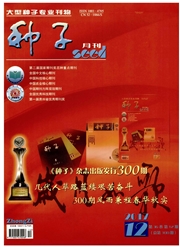

 中文摘要:
中文摘要:
采用不同种类的化学诱变剂和赤霉素处理狭叶薰衣草种子,研究其萌发情况。结果表明:浓度为1.0%的EMS浸种8 h,对狭叶薰衣草种子的发芽势和发芽率均具有显著或极显著的促进作用,而2%的EMS浸种对狭叶薰衣草种子萌发则有显著的抑制作用;不同浓度的秋水仙素浸种对狭叶薰衣草种子发芽势和发芽率均有一定的促进作用,但均在一定程度上推迟种子的萌发。同时,恒温条件下用秋水仙素浸种,种子萌发更快,且发芽率较室温高;GA3处理能显著提高狭叶薰衣草种子的发芽率和发芽势,在GA3浓度为200 mol/L,处理8 h时,狭叶薰衣草种子发芽势和发芽率分别是对照的3.43倍和5.86倍,并与对照差异达极显著水平。
 英文摘要:
英文摘要:
This paper studied the effects of different kinds of chemical mutagens and gibberellins(GA3) on seeds germination of Lavandula angustifolia Mill.The results showed that at a relatively low concentration(1.0%),EMS(with 8 h seed presoaking) significantly promoted both germination viability and germination percentage of Lavandula angustifolia seeds(p0.01 or p0.05),but at high concentration(2.0%,EMS),seeds germination was significantly inhibited(p0.05);After treated with a range of colchicine,the day on which seeds started to germinate delayed,but both germination viability and germination percentage were increased.Besides,constant 20 ℃ were optimum condition for socking seeds with colchicine,with the shorter germination time and higher germination rate than ambient temperature(mean 30.3 ℃);GA3 promoted the seeds germination of Lavandula angustifolia Mill,and the most appropriate concentration was 200 mol/L(with 8 h seed presoaking),the germination viability and germination percentage of the seeds were increased by 2.43 times and 4.86 times respectively,and itshowed a significantly difference(p0.01)with control group.
 同期刊论文项目
同期刊论文项目
 同项目期刊论文
同项目期刊论文
 期刊信息
期刊信息
